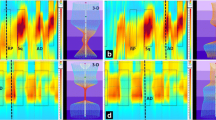Abstract
PURPOSE: Excessive stool frequency and incontinence after anterior resection (AR) or total colectomy (TC) can be refractory to expectancy and antidiarrheal agents. We prospectively assessed efficacy of anorectal biofeedback therapy (BF) in this clinical situation. METHODS: Thirteen patients (10 men and 3 women; mean age, 62.1 (standard error of the mean (SEM), 4.6) years) had more than six bowel movements per day and/or episodes of incontinence, which did not abate after antidiarrheal agents were given for at least six (mean, 27.9 (SEM, 6.3)) months after surgery. All underwent four sessions of outpatient BF. Assessment was by continence questionnaire and anorectal physiology tests, which were administered before and after BF. RESULTS: In seven AR patients, daily stool frequency was decreased (8.7 (SEM, 2.1) before and 4.6 (SEM, 1.2) after; P <0.05), and daily incontinence episodes were reduced (2.7 (SEM, 0.9) before and 0.4 (SEM, 0.2) after; P <0.05) after BF. Six TC patients also had decreased daily stool frequency (6.2 (SEM, 2.1) before, 3.3 (SEM, 1.6) after; P <0.05) and incontinence episodes (2.4 (SEM, 0.9) before, 0.5 (SEM, 1) after; P <0.05) after BF. There were no significant changes in anorectal physiology parameters after BF. At a mean follow-up of 10.6 (SEM, 2.5) months after BF, there were no regressions or complications. CONCLUSIONS: BF is a safe and effective option for refractory excessive stool frequency and/or incontinence following AR or TC.
Similar content being viewed by others
References
Williams DS, Durdey P, Johnston D. The outcome following sphincter-saving resection and abdominoperineal resection for low rectal cancer. Br J Surg 1985;72:595–8.
Nakahara S, Itoh H, Mibu R,et al. Clinical and manometric evaluation of anorectal function following low anterior resection with low anastomotic line using an EEA™ stapler for rectal cancer. Dis Colon Rectum 1988;31:762–6.
McDonald PJ, Heald RJ. A survey of postoperative function after rectal anastomosis with circular stapling devices. Br J Surg 1983;70:727–9.
Engel BT, Nikoomanesh P, Schuster MD. Operand conditioning of rectosphincteric responses in the treatment of fecal incontinence. N Engl J Med 1974;290:646–9.
Cerulli MA, Nikoomanesh P, Schuster MM. Progress in biofeedback conditioning for fecal incontinence. Gastroenterology 1979;76:742–6.
Goldenberg DA, Hersch T, Horacio J. Biofeedback therapy for fecal incontinence. Am J Gastroenterol 1980;74:342–5.
Enck P. Biofeedback training in disordered defecation: a critical review. Dig Dis Sci 1993;38:1953–60.
MacLeod JH. Biofeedback in the management of partial anal incontinence. Dis Colon Rectum 1983;26:244–6.
Griffen FD, Knight CD Sr, Knight CD Jr. Results of the double stapling procedure in pelvic surgery. World J Surg 1992;16:866–71.
Ho YH, Goh HS. Current value of anorectal physiology and biofeedback in clinical practice. Asian J Surgery 1995;18:244–56.
Guillemot F, Bouche B, Gower-Rousseau C,et al. Biofeedback for the treatment of fecal incontinence: long-term clinical results. Dis Colon Rectum 1995;38:393–7.
Enck P, Daublin G, Lubke HJ, Strohmeyer G. Long-term efficacy of biofeedback training for fecal incontinence. Dis Colon Rectum 1994;37:997–1001.
Ho YH, Wong J, Goh HS. Level of anastomosis and anorectal manometry in predicting function following anterior resection for adenocarcinoma. Int J Colorectal Dis 1993;8:170–4.
Lewis WG, Martin IG, Williamson ME,et al. Why do some patients experience poor functional results after anterior resection of the rectum for carcinoma? Dis Colon Rectum 1995;38:259–63.
Batignani G, Monaci I, Ficari F, Tonelli F. What affects continence after anterior resection of the rectum? Dis Colon Rectum 1991;34:329–35.
Carmona JA, Ortiz H, Perez-Cabanas I. Alterations in anorectal function after anterior resection for cancer of the rectum. Int J Colorectal Dis 1991;6:108–10.
Lewis WG, Holdsworth PJ, Stephenson BM, Finan PJ, Johnston D. Role of the rectum in the physiological and clinical results of coloanal and colorectal anastomosis after anterior resection for rectal carcinoma. Br J Surg 1992;79:1082–6.
Pederson K, Hint K, Olsen J, Christiansen HN, Jensen P, Mortensen PE. Anorectal function after low anterior resection for carcinoma. Ann Surg 1986;204:133–5.
Keck JO, Staniunas RJ, Coller JA,et al. Biofeedback training is useful in fecal incontinence but disappointing in constipation. Dis Colon Rectum 1994;37:1271–6.
Miner PB, Donelly TC, Read NW. Investigation of mode of action of biofeedback in treatment of fecal incontinence. Dig Dis Sci 1990;35:1291–8.
Latimer PR, Campbell D, Kasperski J. A component analysis of biofeedback in the management of fecal incontinence. Biofeedback Self Regul 1984;9:311–24.
Loening-Bauke V. Efficacy of biofeedback training in improving incontinence and anorectal physiologic function. Gut 1990;31:1395–402.
Whitehead WE, Burgio KL, Engel BT. Biofeedback treatment of fecal incontinence in geriatric patients. J Am Geriatr Soc 1985;33:320–4.
Ceruli MA, Nikoomanesh P, Schuster MM. Progress in biofeedback conditioning for fecal incontinence. Gastroenterology 1979;76:742–6.
Schiller LR, Santa Ana C, Davis GR, Fordtran JS. Fecal incontinence in chronic diarrhoea: report of a case with improvement after training with rectally infused saline. Gastroenterology 1979;77:751–3.
Buser WD, Miner PB. Delayed rectal sensation with fecal incontinence: successful treatment using anorectal manometry. Gastroenterology 1986;91:1186–91.
Sun WM, Read NW, Miner PB. Relation between rectal sensation and anal function in normal subjects and patients with faecal incontinence. Gut 1990;31:1056–61.
Koletzko S, Herdmann J, Bogermann K, Theisen U, Voit T, Enck P. Evoked potentials and manometry are complementary in the evaluation of anorectal functions [abstract]. Gastroenterology 1991;100:A460.
Benninga MA, van-der-Hoeven CW, Wijers OB,et al. Treatment of faecal incontinence in a child with sacral agenesis: the use of biofeedback training. Dev Med Child Neurol 1994;36:518–27.
Wald A. Biofeedback therapy for fecal incontinence. Ann Intern Med 1981;91:146–9.
Author information
Authors and Affiliations
About this article
Cite this article
Ho, YH., Chiang, JM., Tan, M. et al. Biofeedback therapy for excessive stool frequency and incontinence following anterior resection or total colectomy. Dis Colon Rectum 39, 1289–1292 (1996). https://doi.org/10.1007/BF02055125
Issue Date:
DOI: https://doi.org/10.1007/BF02055125




